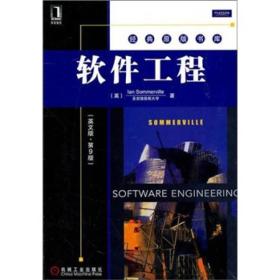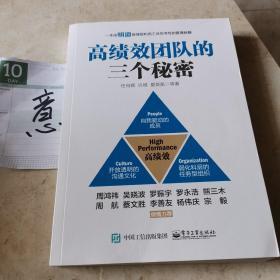
软件工程(英文版·第9版)
¥ 8.02 八五品
仅1件
作者[英]萨默维尔 著
出版社机械工业出版社
出版时间2011-06
版次1
装帧平装
货号126GF
上书时间2024-06-28
- 在售商品 暂无
- 平均发货时间 6小时
- 好评率 暂无
- 店主推荐
- 最新上架
商品详情
- 品相描述:八五品
图书标准信息
- 作者 [英]萨默维尔 著
- 出版社 机械工业出版社
- 出版时间 2011-06
- 版次 1
- ISBN 9787111348252
- 定价 99.00元
- 装帧 平装
- 开本 16开
- 纸张 胶版纸
- 页数 773页
- 【内容简介】
-
《软件工程(英文版·第9版)》特点:
·涵盖了对所有开发过程都很基础的重要主题,包括软件工程理论与实践的最新进展。
·将第8版中的八篇内容重构为四个部分,使教师讲授软件工程课程更加容易。
·每一章都有30%~40%的更新,增加了敏捷软件开发和嵌入式系统等新章,补充了模型驱动工程、开源开发、测试驱动开发、可依赖系统体系结构、静态分析和模型检查、cots复用、服务作为软件以及敏捷规划等新内容。
·着重讨论了开发可靠的分布式系统的相关主题以及敏捷方法和软件复用。
·反映敏捷方法先进性的同时,不忘强调传统的计划驱动软件工程的作用,阐述了两者结合构建优秀软件系统的重要性。
·以一个新的病人记录系统案例研究贯穿始终,系统、完整地讲解软件工程的各个方面。
·设计为“印刷/web”相结合的方式,核心信息采用印刷版本,教辅材料及先前版本中的一些章节放在web上,为读者提供丰富翔实的信息。 - 【作者简介】
-
lan Sommerville 英国著名软件工程专家,曾任教于兰卡斯特大学,现为安德鲁斯大学软件工程学教授。他在软件工程的教学和科研方面有20多年的经验,是IEEE CS组织编撰“软件工程知识体系”(SWEBOK)的专家委员会成员之一。他的研究领域包括计算机系统工程、需求工程、系统可靠性以及软件进化。
- 【目录】
-
preface v
part 1 introduction to software engineering
chapter 1 introduction
1.1 professional software development
1.2 software engineering ethics
1.3 case studies
chapter 2 software processes
2.1 software process models
2.2 process activities
2.3 coping with change
2.4 the rational unified process
chapter 3 agile software development
3.1 agile methods
3.2 plan-driven and agile development
3.3 extreme programming
3.4 agile project management
3.5 scaling agile methods
chapter 4 requirements engineering
4.1 functional and non-functional requirements
4.2 the software requirements document
4.3 requirements specification
4.4 requirements engineering processes
4.5 requirements elicitation and analysis
4.6 requirements validation
4.7 requirements management
chapter 5 system modeling
5.1 context models
5.2 interaction models
5.3 structural models
5.4 behavioral models
5.5 model-driven engineering
chapter 6 architectural design
6.1 architectural design decisions
6.2 architectural views
6.3 architectural patterns
6.4 application architectures
chapter 7 design and implementation
7.1 object-oriented design using the uml
7.2 design patterns
7.3 implementation issues
7.4 open source development
chapter 8 software testing
8.1 development testing
8.2 test-driven development
8.3 release testing
8.4 user testing
chapter 9 software evolution
9.1 evolution processes
9.2 program evolution dynamics
9.3 software maintenance
9.4 legacy system management
part 2 dependability and security
chapter 10 sociotechnical systems
10.1 complex systems
10.2 systems engineering
10.3 system procurement
10.4 system development
10.5 system operation
chapter 11 dependability and security
11.1 dependability properties
11.2 availability and reliability
11.3 safety
11.4 security
chapter 12 dependability and security specification
12.1 risk-driven requirements specification
12.2 safety specification
12.3 reliability specification
12.4 security specification
12.5 formal specification
chapter 13 dependability engineering
13.1 redundancy and diversity
13.2 dependable processes
13.3 dependable system architectures
13.4 dependable programming
chapter 14 security engineering
14.1 security risk management
14.2 design for security
14.3 system survivability
chapter 15 dependability and security assurance
15.1 static analysis
15.2 reliability testing
15.3 security testing
15.4 process assurance
15.5 safety and dependability cases
part 3 advanced software engineering
chapter 16 software reuse
16.1 the reuse landscape
16.2 application frameworks
16.3 software product lines
16.4 cots product reuse
chapter 17 component-based software engineering
17.1 components and component models
17.2 cbse processes
17.3 component composition
chapter 18 distributed software engineering
18.1 distributed systems issues
18.2 client–server computing
18.3 architectural patterns for distributed systems
18.4 software as a service
chapter 19 service-oriented architecture
19.1 services as reusable components
19.2 service engineering
19.3 software development with services
chapter 20 embedded software
20.1 embedded systems design
20.2 architectural patterns
20.3 timing analysis
20.4 real-time operating systems
chapter 21 aspect-oriented software engineering
21.1 the separation of concerns
21.2 aspects, join points and pointcuts
21.3 software engineering with aspects
part 4 software management
chapter 22 project management
22.1 risk management
22.2 managing people
22.3 teamwork
chapter 23 project planning
23.1 software pricing
23.2 plan-driven development
23.3 project scheduling
23.4 agile planning
23.5 estimation techniques
chapter 24 quality management
24.1 software quality
24.2 software standards
24.3 reviews and inspections
24.4 software measurement and metrics
chapter 25 configuration management
25.1 change management
25.2 version management
25.3 system building
25.4 release management
chapter 26 process improvement
26.1 the process improvement process
26.2 process measurement
26.3 process analysis
26.4 process change
26.5 the cmmi process improvement framework
glossary
subject index
author index
— 没有更多了 —





















以下为对购买帮助不大的评价